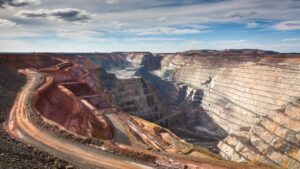Ground Breakers: Hemi monster awakens as DFS confirms De Grey as owner in waiting of Top 5 Aussie gold mine

Pic: Nazar Rybak/iStock via Getty Images
- De Grey confirms Hemi’s status as one of Australia’s biggest future gold mines in landmark DFS at 530,000ozpa over a decade
- $300 million raising will help De Grey fund early works and long lead items ahead of debt funding for $1.3 billion Pilbara gold mine
- MD Glenn Jardine says bringing Hemi into production will be the best way to maximise shareholder returns
De Grey Mining (ASX:DEG) has confirmed it plans to deliver one of Australia’s biggest gold mines by the second half of 2026, confirming its imminent shift from explorer to developer of the world class Hemi discovery near Port Hedland in WA’s re-emerging North-West Goldfields.
If you had any doubt the scale of the thing would follow through from its landmark scoping and pre-feasibility studies, there is little hint of growing pains with the multi-bagger’s final numbers.
The now 9.5Moz Hemi deposit, which saw De Grey become one of Australia’s biggest gold companies after its discovery in early 2020, will deliver 530,000ozpa over its first decade of life and 553,000oz across its first five years from a 6Moz reserve at a grade of 1.5g/t.
That will all occur at lowest quartile costs of $1229/oz for the first five years and $1295/oz for the decade, with 99% of the planned gold production over its 12-year life already in reserve.
Capex, as would be expected in the current inflationary environment, is up 28% to $1.3 billion with $162m of contingency and growth allowance and $47m of pre-strip costs.
But it still pays back in 1.8 years post-tax, with a 36% post-tax IRR and $2.9b post-tax NPV5 and $4.5b in post-tax undiscounted cash-flow at prices of $2700/oz (around $250 cheaper than current spot gold prices) with a total economic contribution to WA, the Pilbara and Australia of $10.8b.
Compared to Australia’s last year of gold production Hemi will be placed third behind US giant Newmont’s Boddington and (soon to be Newmont’s) Cadia mines.
The others in the top-5 would be Newmont’s Tanami mine and AngloGold-Ashanti and Regis Resources’ (ASX:RRL) Tropicana, making Hemi potentially the only Top 5 gold mine in Australia to have full local control.
And strengthening De Grey’s case to develop the project on its lonesome and kick early works off, the company has revealed a $300m placement today that will give it a $384m war chest, bankrolling $54m in exploration, $30m to finalise engineering, contracting and approvals, $116m for long-lead items and $38m for early works.
Could this get even bigger?
Stocking up in the placement was Gold Road Resources (ASX:GOR), the dividend-paying half-owner of the Gruyere gold mine which has maintained a 19.9% stake in De Grey.
While both have similar market caps at around $1.75 billion, it keeps Gold Road’s foot in the door for any M & A activity that may come for the mega gold project.
Already massive in scale, De Grey has flagged growth opportunities by extending its key Diucon and Eagle pits on the back of extensions uncovered in drilling after the DFS mine design cut-off period.
Hemi’s cashflows may also be used to develop a second concentrator at the nearby 1.7Moz Withnell deposit to the west to the tune of 150,000ozpa for regional deposits previously planned to go through the Hemi plant.
Another 1Moz of mineral resources also sits underneath the 390m limit of the Hemi open pits and could be developed concurrently with the open pits in future. An updated resource is due later this year looking at the Hemi deeps.
So how will it be funded?
CFO Peter Canterbury said on a call with analysts the De Grey board is yet to decide exactly how the project will be funded, including the mix of debt and equity that will be sought to bring Hemi into production.
Full construction activities at Hemi won’t take place until the second half of next year, with shortlisted debt providers to peruse the DFS and independent technical report ahead of the issuing of term-sheets.
MD Glenn Jardine said the raising would get De Grey through to the middle of next year without settling on what it needed in terms of debt.
“In terms of the interim raising, I think we’re talking about approximately or at least $150 million of that raising through project activities and also the ordering of long lead time items coming off that final capital cost number of $1.298b for the plant,” he said.
“So that’s a positive outcome, but in terms of any other details we will continue with looking at all the options around project financing and then we’ll come out with our final equation on that.
“But as Peter pointed out previously the debt-carrying capacity of the project is not limited by the cash flow from operations. So the potential is that $800 million is buried in a positive fashion in terms of the potential debt-carrying capacity of the project.
“So we don’t want to necessarily start doing the subtractions and additions and so forth right now because there’s a lot more work going on.”
Could De Grey consider a sell down to help develop the mine and deliver returns for shareholders? That, for instance, was the path taken by significant shareholder Gold Road, which brought South African giant Gold Fields on board to build and operate its 350,000ozpa Gruyere mine.
Jardine said the best way to maximise returns was to bring the mine into production.
“We consider all options when it comes to developing the project and we’ve been modeling that since 2020, actually, probably mid 2020,” he said.
“So we’re not saying that we’re developing this from an ideological perspective or that we want to play in our own sandpit up there in the Pilbara.
“Our decision making is purely driven by maximising shareholder returns. And of all the options that we’ve looked at to this point, we maximise shareholder returns by De Grey bringing Hemi into production.”
De Grey Mining (ASX:DEG) share price today
At Stockhead we tell it like it is. While De Grey Mining is a Stockhead advertiser at the time of publishing, it did not sponsor this article.
Related Topics

UNLOCK INSIGHTS
Discover the untold stories of emerging ASX stocks.
Daily news and expert analysis, it's free to subscribe.
By proceeding, you confirm you understand that we handle personal information in accordance with our Privacy Policy.








